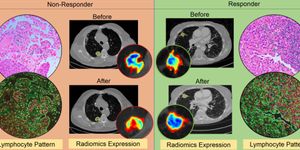Discovery of mechanism behind Alexander disease may lead to enhanced drug development
Researchers have long known that the cause behind Alexander disease is a genetic culprit—mainly a mutation leading to the production of a defective protein called GFAP. Alexander disease (AxD) is a rare neurological condition involving myelin destruction and is present during many stages of life: infancy, adolescence, or adulthood. Many of those diagnosed with condition pass away with the first years of diagnosis. Although, some can survive for several decades, babies born to the condition experience seizures and developmental delays.
Immunofluorescence staining of Alexander Disease iPSC-astrocytes showing cell nuclei (white), cytoplasmic GFAP filaments (magenta), and perinuclear GFAP aggregates (green; marked by yellow arrowheads). (Caption and Image Credit via UNC Healthcare)
Now, a new research study at UNC School of Medicine examined the differences in severe and milder forms of AxD for the first time. Through their studies, they discovered that the mutant form of GFAP undergoes diverse chemical modifications depending on the time of when symptoms appear, and these modifications can be manipulated by scientists using an in-vitro system taken from AxD patient cells. The research could potential provide the basis of drug discovery and development.
"We are now further investigating the enzymes responsible for the key reactions inside brain cells that lead to AxD," says research leader, Natasha Snider. "We believe our research findings may open the door to new drug development opportunities for researchers and ultimately new kinds of therapies for people with this terrible disease. But ours is the first demonstration of this phenomenon in a model cell line in the lab to help us probe how exactly GFAP accumulation affects other cellular organelles to cause disease."
Findings were published in the online journal, eLife.
AxD is consider part of a group of nervous system disorders known as the leukodystrophies which involve the destruction of myelin—a insulating fatty material that improves neuronal cell communication.
Learn more about leukodystrophies:
Source: UNC Healthcare









